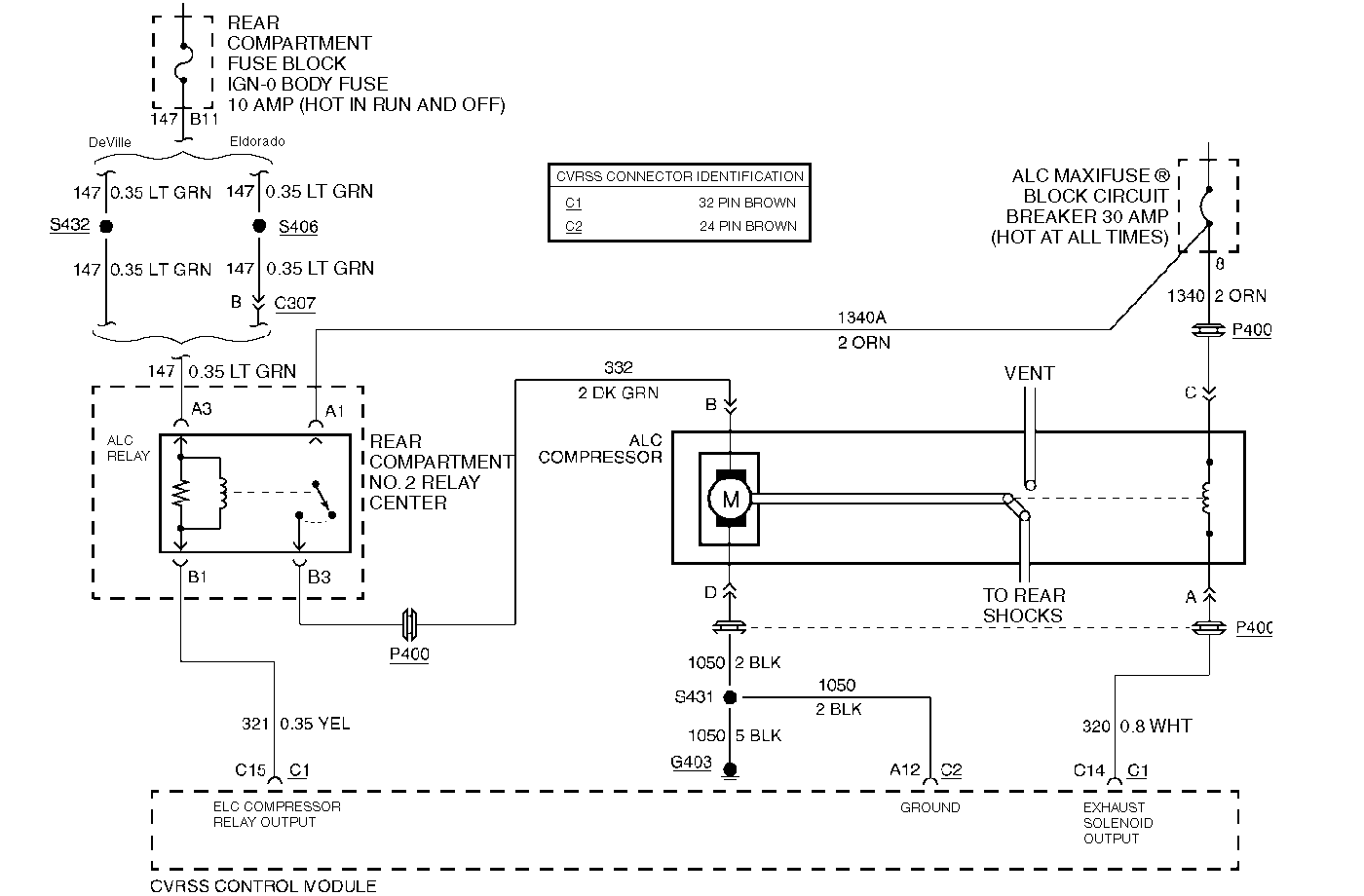
Circuit Description
The compressor is switched ON and OFF via an ELC compressor relay which is controlled by the CVRSS control module. The control module circuitry provides a switched path to ground (low-side drive) whenever compressor activity is required. This drive circuit is also continually monitored to determine if the voltage level agrees with the commanded state.
Conditions for Setting the DTC
The DTC is set when the CVRSS control module sees a low voltage condition at pin C15 during a compressor OFF-state.
The DTC will turn HISTORY when the CVRSS control module no longer senses a low voltage condition at pin C15 while the ELC compressor relay output drive is in an OFF-state.
Action Taken When the DTC Sets
The ELC compressor relay output drive is disabled for the remainder of the ignition cycle.
Conditions for Clearing the MIL/DTC
| • | Use the scan tool. |
| • | Refer to the CLEAR RSS CODES feature. |
Diagnostic Aids
This fault condition is detectable only when the ELC compressor relay output is commanded to the OFF state, which occurs whenever compressor activity is not required. The control module expects to see a high voltage condition during the OFF-state.
Only electrical problems with the ELC compressor relay coil circuit are flagged. Compressor motor problems and pneumatic leakage problems do not set a DTC, but the CVRSS control module shuts the ELC compressor relay off if there is no progress, or if excessive run times occur. Recovery is not attempted until the ignition is cycled OFF and ON.
Test Description
Important:
• Do not backprobe the sensors, actuators, or any sealed connectors. • When all the diagnostics and repairs are complete, clear the DTCs
and verify the operation.
The number(s) below refer to the step number(s) on the diagnostic table.
-
This step checks to see if the ignition fuse to the relay is blown.
-
This step checks to see if ignition voltage is present.
-
This step checks for an open circuit condition or short circuit to ground condition in CKT 321.
-
This step checks for an internal open circuit condition in the relay coil.
-
This step checks for an open circuit condition in CKT 147.
-
This step checks for a short circuit to ground condition in CKT 147.
Step | Action | Value(s) | Yes | No |
|---|---|---|---|---|
1 | Was the CVRSS System Check performed? | -- | Go to Step 2 | |
Is the fuse blown? | -- | Go to Step 9 | Go to Step 3 | |
Is the measurement greater than the specified value? | 10 V | Go to Step 11 | Go to Step 4 | |
Was a problem in CKT 321 found? | -- | Go to Step 5 | Go to Step 6 | |
5 | Repair the short or open circuit condition in CKT 321. Is the repair complete? | -- | -- | |
Measure the resistance between pin A3 and pin B1 of the ELC relay (device side). Is the measurement within the specified values? | 45-49 ohms | Go to Step 7 | Go to Step 13 | |
Check for an open circuit condition in CKT 147. Was an open circuit condition found? | -- | Go to Step 8 | Go to Step 11 | |
8 | Repair the open circuit condition in CKT 147. Is the repair complete? | -- | -- | |
Check for a short circuit to ground condition (continuity) between CKT 147 and ground. Was a short to ground circuit condition found? | -- | Go to Step 10 | Go to Step 15 | |
10 | Repair the short circuit to ground condition between CKT 147 and ground. Is the repair complete? | -- | Go to Step 12 | -- |
11 |
Is DTC C1736 set? | -- | Go to Step 14 | |
12 | Replace the IGN-0 BODY fuse. Is the replacement complete? | -- | -- | |
13 | Replace the ELC relay. Is the replacement complete? | -- | -- | |
14 |
Important: The controller must be calibrated. Is the CVRSS control module calibrated? | -- | -- | |
15 | Replace the IGN-0 BODY fuse. Is the replacement complete? | -- | Go to Step 11 | -- |
